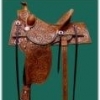-
Posts
240 -
Joined
-
Last visited
Contact Methods
-
Website URL
http://
Profile Information
-
Gender
Male
Recent Profile Visitors
9,948 profile views
JRedding's Achievements

Member (2/4)
-

Would Like Some Critiquing Please
JRedding replied to Themasonstouch's topic in Floral and Sheridan Carving
It goes something like this, find or layout a pattern on paper so you're sure it's what you want, carve the borders, trace on the pattern, carve the floral you just traced, flower centers are first, pear shade the flower petals, then bevel the borders then the floral, then background and finish cut, that's an abbreviated version there's a lot of steps like veining, back shadowing, mules foot etc. that can be added in there but that's the shortened version of the steps I do. Even without hands on instruction from someone you can find work done by a good tooler and study it, what tools are used, and how they're used, can get you a long way on your own. Good Luck stick with it -
Like I said it all works, you definitely get good results with your method, I learned the way I do it in large because I spent a couple decades in a saddle shop with four under construction all the time, and all the covering, uncovering, and waiting as you described didn't work very well with that much leather in front of me all the time, I've been in some of the finest shops in the country and seen both methods and a few things I never was sure what they were doing all produce great results. I've read Hidepounders method and it's a good one, you can see it in what he does. I gotta say though I've never seen anyone go through all those steps you described with a stack of saddle parts, they'd have never been able to go home. I learned what I do from a Japanese guy in Ft. Worth tooling at Ryon's shop at the stockyards when I worked for them. He would tool right handed non stop until his arm got tired of hammering and then change hands and tool left handed. He was paid by the saddle and did beautiful work but I assume that's why the not much waiting method was perfected.
-
It was too wet no big deal everybody starts too wet, everybody does it different, ya just have to find what works for you. I can give you my take on it, my methods on this are unconventional but they work, and I have my reasons for doing it like I do. Casing is widely known as the method to use and not saying it doesn't work it does I just don't do it. The theory behind casing is to let the moisture become consistent throughout the thickness of the leather, why ? your not tooling to the bottom, moisture clear to the bottom only lets it stretch more, if the portion you're not tooling into remains solid it helps limit stretch. And getting a good case on leather is a real moving target, every piece of leather is different, how pourous it is makes a huge variable, as to how much moisture it sucks in, and how much it try's to hold onto. Relative humidity is the other big variable, it reacts a lot different in Arizona than it does in Texas for sure, every seasonal change only adds to the equation. Some perfect it but it's time consuming to learn and cased leather is like having a milk cow, your on its schedule now. I just spray bottle it, first time I give it enough I think it went to tooling depth and let it sit until it almost appears dry, give it a light spray and get on with it, you do have to spray a little as you move along to maintain a consistent surface but it's no big deal to learn to judge it. Tool as dry as it will let you while still using a reasonable amount of force. Spraying allows you to easily read and adjust to every piece of leather you come across, and it's not demanding that you be right there when it's ready. That's long but it's not a small topic in leatherwork, hope that helps
-

A Few Projects
JRedding replied to JRedding's topic in Purses, Wallets, Belts and Miscellaneous Pocket Items
Thank you all, but I have had a bit of an advantage, I did this full time for twenty years so I've dedicated a little more time to it than a lot of folks, I see many people with talent to do the same given the opportunity of that kind of time. And that belt isn't as difficult as it looks, it's really the simplest figure carving that can be done if you really look at it, the hardest part is the painting and dyeing . -
You did the right thing, what is someone with beliefs like that doing dragging a dog around on a leash ? What about his rights ? How would she like to be on a leash ? BLAH, BLAH, BLAH, a lot like watching people come here to protest the oil and gas industry, nobody shows up riding their bike.
-
It appears to have been too moist, please tell how you wet your leather to prepare it and I can help you from there
-
It's been a while since I've frequented Leatherworker and I see a lot of new members I've never met so I thought I'd post a little of my work just to say hello again.
-
The easiest way to clean up a nasty flesh side is rough cut a piece larger than your project piece and just put it on a bench type belt sander, 100 or 120 usually does a nice finish, don't be shy just sand it until it cleans up, as long as you don't burn it you can't hurt it just clean it up, you can buy skirting that is sanded at the tannery made specifically for building rough out saddles, it's called " buffed " I think Hermann Oak is the only one I know of that does it but you can do any small piece just the same yourself
- 30 replies
-
- flesh side
- burnishing
-
(and 1 more)
Tagged with:
-
I've done a lot of hidden stitch binders except they were split and sewn through the bottom layer, I like to do them this way but I'm not sure about just glueing them down with no stitch. I don't know what the advantage of that would be since you're sewing it anyway. My question is are you absolutely sure it isn't split if done well it can be very hard to detect, and would you mind telling what the make is of the saddle that may reveal something as to the technique ?
-
I know a lot of people don't use them these days but using and mastering a good round knife will bring the best results with the least amount of work.
-
Thanks for all the effort it took to explain this to me, I've never worked the stuff and was interested how it was done and what the lasting results would be of a modification like this. Thanks again
-
I guess I need to rephrase my question, what attaches the bondo portion of this undertaking to the original saddle tree, it seems it would snap off fairly easy and be a floating loose piece of bondo hovering on top of the original cantle held in place only by the leather of the seat and cantle back.???
-
How do you intend to adhere the bondo portion of this to the narrow top edge of the cantle and not have it separate ?
-

Just Bought A Nile Crocodile Backstrap
JRedding replied to leatherman2011's topic in How Do I Do That?
I don't fully understand the process myself having never done it, my understanding is that it requires a specialized machine to do it properly. I've looked at the finished product of it and it's not something I could do in a plain old saddle shop by hand so I never took any further interest in studying it. The photo you posted is a very fine job I think, it doesn't appear to be bench made to me but more of a very good production belt. It does appear to be built over a beveled inner liner that I really like the looks of. Without being able to see it in person I'd guess it is three ply, the gator, the beveled inner core and a lining on the back. But that's just a guess, maybe that's something to research if you want that look. -

Just Bought A Nile Crocodile Backstrap
JRedding replied to leatherman2011's topic in How Do I Do That?
I'll try to answer your questions with what I know about working exotics into belts, 9/10 oz. latigo plus probably 3oz. croc is going to be a really stiff, heavy belt. I'm assuming when you say gun belt you mean something normal not Dirty Harry huge so you may want to get the opinion of some of the guys who build a lot of gun belts on here my experience with gun belts is limited so I'd check that out with someone who knows more than I do before you begin.Any sharp knife will cut it o.k. I use a round knife for everything so that's my suggestion, I wouldn't try shears or scissors of any kind if you want a straight cut. If it's decent croc you shouldn't have to dress the back up before you use it. Most gator or croc belts are dress belts and the edges are skived, rolled and glued under pressure, no stitching at all. Working it into a two-ply belt and finishing the edge isn't something I'd recommend if you want a first rate job it doesn't burnish well, I've seen it done with tons of edge dye and dressing smoked into the edges but results are amatuar at best doing that, and it doesn't hold up well over time. I've made a lot of exotics into belts before and always made laced edge belts out of them for that reason so that may be something to consider doing instead of sewing and burnishing edges. Any finish dressing like Bag-Kote, Neat-Lac or something similair that you like will add a nice finished look when you're done Sure that didn't solve all your problems but maybe something in there will help..










